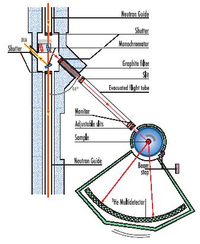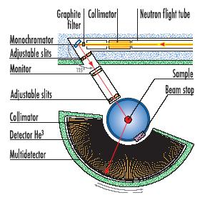Instruments
The ILL's diffraction instruments are divided into two main groups: powder diffractometers and single-crystal diffractometers.
In this page you will find a very short description of our instruments. If you are interested in more detailed information, you can consult the official page of the instrument (mantained by each Instrument Scientist).
Powder diffractometers
These two-axis diffractometers are used to investigate the structure of powders, liquids and amorphous materials. Diffraction group machines use relatively short wavelength neutrons (0.3 to 2.0 Å) to resolve structures to atomic resolution, in contrast to diffractometers in the Large Scale Structures group that use long wavelength neutrons for lower resolution of larger structures. Usually a large composite monochromator, up to 300 mm high, is used to select a narrow band of wavelengths and focus it onto the sample.The monochromator may be made from several crystals of pyrolytic graphite, copper or germanium. Large multi-detectors and linear position-sensitive detectors (PSDs) cover a large solid angle for maximum efficiency.
The two high-resolution powder diffractometers D1A and D2B are used mainly for Rietveld refinement, with scans lasting from 30 minutes to several hours. They are complemented by two high-flux medium-resolution powder machines, D1B and D20, which are used mainly for temperature scans and other types of fast experiment, especially on small samples. D4, on the short wavelength hot source, is used for liquids and amorphous materials, together with D20.
Single-crystal diffractometers
Single-crystal diffraction is a powerful method for the investigation of structural details in condensed matter. Hot neutrons are required to uncover the finest details in the nuclear positions and neutron spin polarisation is a handle to separate mixed components (nuclear polarisation, magnetic and electronic scattering).
A characteristic of the four-circle diffractometers is the use of Eulerian cradles for orienting the sample crystals, with the detector moving in a horizontal plane. Normal-beam diffractometers have a mechanism for tilting the counter out of the horizontal plane, thus enabling the installation of heavy equipment for special crystal environments (cryostats, magnets, etc.).
These diffractometers can be used to find:
- average atomic positions. From these we can learn how the atoms are bound together to form molecules, and how the molecules are stacked;
- local atomic distributions. This gives information about the time averaged thermal motion or the local atomic disorder;
- magnetic structures and magnetic moment distributions.
Structural data of this kind are required for a large number of systems, ranging from organic molecules to high temperature superconductors. Often studies are made as a function of temperature, pressure and magnetic field which may lead to important modifications of the crystal structure.
D1B
Two-axis diffractometer D1B
D1B has always been in very high demand for real time experiments, and for very small samples because of its high efficiency position sensitive detector (PSD). Although it is a CRG instrument, (run by a CNRS team and Spain), it is available 50% of the time for scheduled ILL experiments. Complete diffraction patterns covering 80° at moderate resolution can be collected in a few minutes.
D2B
Very high-resolution two-axis diffractometer D2B
D2B was designed to achieve the ultimate resolution, limited only by powder particle size (Δd/d ~ 5 x 10-4), but was built so that an alternative high flux option, with resolution comparable to that of D1A but much higher intensity, could be chosen at the touch of a button. D2B then has very high intensity at D1A resolution, or very high resolution at D1A intensity. Being on a beam tube in the reactor hall, it can use wavelengths as short as 1.05 Å, impossible on D1A. The D2B detector bank was recently replaced by a pseudo-2D detector with 6 times the solid angle, and data can now be collected on samples as small as 500 milligrams in a few hours, or normal samples of a few grams in a few minutes.




